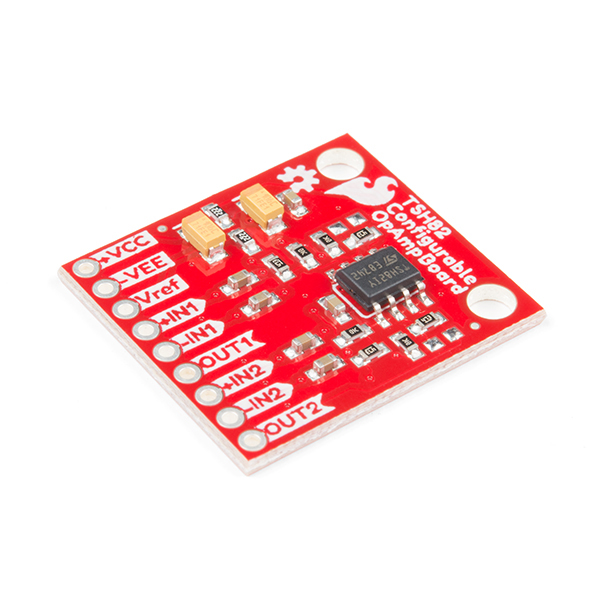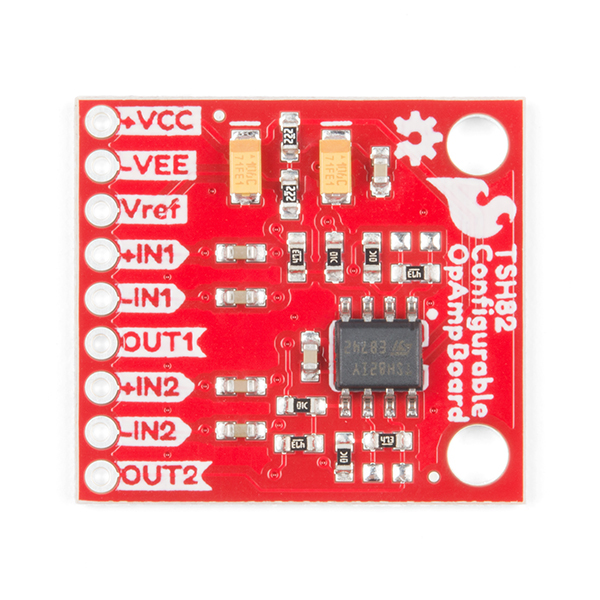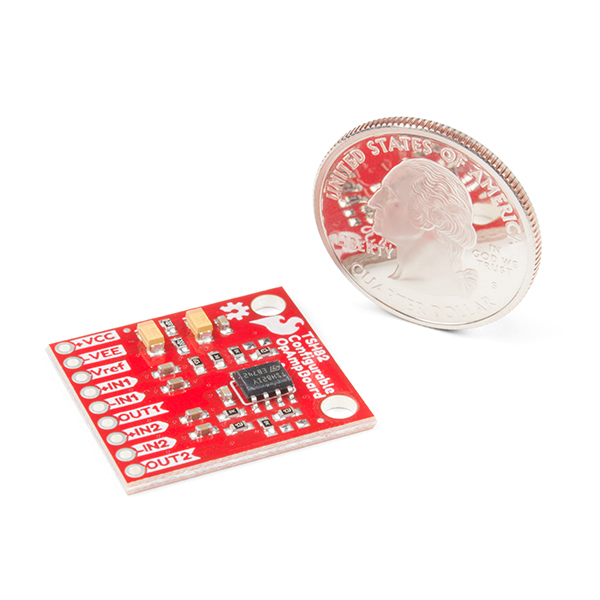SparkFun Configurable OpAmp Board - TSH82
The SparkFun TSH82 Configurable OpAmp Board was designed to give you the best combination of performance and flexibility that we could achieve by giving you two gain stages, each one independently accessible on the header pins. Each stage is natively configured as an inverting amplifier that can also be strung together to expand the capabilities of the TSH82 from STMicroelectronics. With the use of the jumpers on the back of the board, you can configure each stage for non-inverting operation, differential input, and DC input coupling.
Electrically speaking, both stages on this board are identical. The default configuration is inverting with a gain of -4.7 with a bandwidth of almost 10MHz. Input signals are AC coupled, possess an input impedance of 10K with a low frequency cutoff of 15.9Hz. Outputs are also DC coupled, so don’t forget to add a capacitor to the output if you’re running a single-ended supply and need to strip out the DC component. The board will also operate with a single-ended DC power supply of 4.5V to 12V, or a bipolar supply from +/-2.25V to +/-6V.
On the back of the board you’ll find 10 solder jumpers that can be used to change the board’s performance, but nothing there needs to be changed to use it in it’s default state.
- Schematic
- Eagle Files
- Hookup Guide
- Datasheet (TSH82)
- GitHub
SparkFun Configurable OpAmp Board - TSH82 Product Help and Resources
TSH82 Configurable OpAmp Hookup Guide
November 2, 2018
The TSH82 Configurable OpAmp board offers the designer a great balance of performance and flexibility. We'll show you how to get the very best out of your board!
Introduction to Operational Amplifiers with LTSpice
April 18, 2017
Picking up where we left off in "Getting Started with LTSpice," we delve a little deeper into LTSpice through an introduction of Operational Amplifiers (OpAmps).
Core Skill: Soldering
This skill defines how difficult the soldering is on a particular product. It might be a couple simple solder joints, or require special reflow tools.
Skill Level: Noob - Some basic soldering is required, but it is limited to a just a few pins, basic through-hole soldering, and couple (if any) polarized components. A basic soldering iron is all you should need.
See all skill levels
Core Skill: Electrical Prototyping
If it requires power, you need to know how much, what all the pins do, and how to hook it up. You may need to reference datasheets, schematics, and know the ins and outs of electronics.
Skill Level: Rookie - You may be required to know a bit more about the component, such as orientation, or how to hook it up, in addition to power requirements. You will need to understand polarized components.
See all skill levels
Comments
Looking for answers to technical questions?
We welcome your comments and suggestions below. However, if you are looking for solutions to technical questions please see our Technical Assistance page.
Customer Reviews
4.7 out of 5
Based on 3 ratings:
OpAmp Board-TSH82
Bought 4 of these boards as they are very reasonable. Upon receipt soldered on pin headers so I could plug into my prototyping board. Plugged it in and powered it up. Connected my signal generator to get an idea of board performance starting with one amp and then both amps in series. Great performance beyond my expectations. Then modified 1st amp to act as current sensitive amp. My SMD soldering is marginal at best but the amp survived and functions. Not finished testing it though. This will be used as a preamplifier for a photomultiplier tube. Will also test these for bio-electrical amps but that is planned for later, Need much more practice on soldering SMD devices!! Thanks for the design and production of this analog break out board.
0 of 1 found this helpful:
too complicated to use
I bought a pair of these to amplify the signal from some coil-style amp probes. really takes an EE to make sense of these.
Very nice well thought out utility board
Very nicely done for what it is designed to do. Option jumpers well thought out. ONE "TINY" LITTLE SUGGESTION would be to make it just a little larger & use 0805 components instead of 0603. If you need to change a value its a lot easier to deal with rework with the larger 0803 geometry part. If someone REALLY needs a small board you could do this in 1/2 the space or less with a dedicated (no options) layout, but it doesn't seem to me that smallest size is a significant point with a building block board.
Excellent assembly workmanship.






Has anyone jumpered the C4 and C5 pads to make unity gain voltage followers?